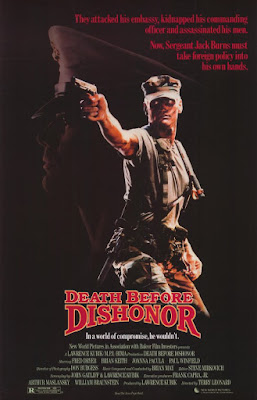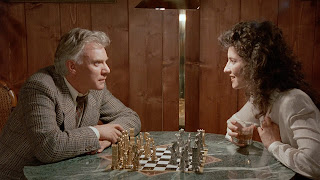SPLIT SECOND
(UK - 1992)
Directed by Tony Maylam and Ian Sharp. Written by Gary Scott Thompson. Cast: Rutger Hauer, Kim Cattrall, Neil Duncan, Michael J. Pollard, Alun Armstrong, Pete Postlethwaite, Ian Dury, Tony Steedman, Steven Hartley, Sarah Stockbridge, Ken Bones, Dave Duffy, Stewart Harvey-Wilson, Paul Grayson, Chris Chappel, John Bennett. (R, 91 mins)
"We need to get bigger guns! Big fucking guns!"
Few films scream "early '90s at the video store" like SPLIT SECOND. After making a quick exit from American theaters in May 1992, the British import went on to be discovered by a more appreciative audience on home video, where it got a second wind and became a legitimate word-of-mouth cult hit. It's also an essential for fans of Rutger Hauer, by then a fixture in B-movies, with SPLIT SECOND being one of his best. He stars as Harley Stone, a renegade, plays-by-his-own rules cop in a near-future hellscape of 2008 London, with the city feeling the effects of global warming and largely submerged in perpetual flooding after 40 days and nights of torrential rain. It's a dark, dreary, smoggy, neon-lit, waterlogged hellhole with a production design that's typical of dystopian British cinema of the time, whether it's Richard Stanley's HARDWARE (1990), Bob Keen's PROTEUS (1995), and Stephen Norrington's DEATH MACHINE (1995) to name a few. Norrington would go on to direct big-budget Hollywood productions like BLADE (1998) and THE LEAGUE OF ORDINARY GENTLEMEN (2003), but before that, he worked on the effects and design crew of both HARDWARE and SPLIT SECOND, making him a key figure in this period of British genre fare. SPLIT SECOND had a long and troubled journey to the screen, with the script by Gary Scott Thompson (who would later go on to co-write THE FAST AND THE FURIOUS and subsequently cash in on that "Based on characters created by" action) initially making the rounds in 1988 as an L.A.-set Satanic serial killer thriller titled PENTAGRAM and written with Harrison Ford in mind. That never happened, as it ended up being put in turnaround after the similar Lou Diamond Phillips chiller THE FIRST POWER hit theaters in 1990.
After some rewrites and some additional tweaks and several title changes, the script made its way to Hauer and he liked it. Production began in June 1991 with director Tony Maylam (best known for 1981's post-FRIDAY THE 13th slasher THE BURNING) at the helm. Rewrites continued throughout the shoot and after several weeks, Maylam exited the production over "creative differences" and Ian Sharp (THE FINAL OPTION) was brought in to finish the film, with an "additional sequences directed by" credit at the end. SPLIT SECOND is pretty incoherent at times, and the end result barely hangs together, but it's got enough style, action, and Rutger Hauer being fucking awesome that it succeeds in spite of everything wrong with it. Like any cop who plays by his own rules, Hauer's Stone is constantly on suspension, and often so out of control that it's not unusual for him to be detained and placed under psychiatric observation. He "lives on anxiety, coffee, and chocolate" in a hoarders' nightmare shithole of an apartment that would take several deep cleanings to reach condemned status. He hasn't been the same since the murder of his partner in the line of duty, and not even a brief fling with the partner's widow Michelle (Kim Cattrall) made things any better. That was three years ago, and now the same Satanic serial killer who killed his partner is back (we know this because "I'm back!" is tauntingly written in blood at a murder scene), offing victims, ripping out their hearts, and sometimes eating them. Stone ("I work alone!") is teamed with dweeby, brainy new partner Dick Durkin (Neil Duncan) in a classic "...if they don't kill each other first!" mismatch, but they gradually bond amidst constant ballbusting and quotable dialogue. The body count continues to rise, there's something about the murders taking place at the start of the new moon when the tide is highest, and the killer is some kind of ten-foot-tall supernatural creature that's able to absorb the DNA of its victims both dead and surviving, which explains why Stone has developed a psychic connection to it, having been scratched and left scarred in a confrontation years earlier.
SPLIT SECOND's wild plot developments have a pretty obvious "making it up as they go along" aura, but Hauer and Duncan are such a great team that you can't help but roll with whatever bullshit the filmmakers throw at you (there's a scene where they're jawing at each other as Duncan breaks and Hauer starts grinning but keeps it together, and they just left it in, and you know what? It's perfect). They bust each other's chops, they get chewed out by their blustering boss Thrasher (Alun Armstrong as Bob Hoskins as Frank McRae), and Stone has a perfect foil in asshole, desk jockey precinct adversary Paulsen (a pre-mainstream success Pete Postlethwaite), which generates some amazing shouting throughout, particularly during one epic rant from Armstrong. Duncan's manic, Roy Scheider-like freakout after a near-fatal encounter with the creature ("We need bigger guns!") got a lot of laughs in the theater, as did any number of zingers like "Zip up, Dick," Stone's coffee-stirring staredown with Paulsen, and his incredulous reactions to Durkin's repeated boasting about how much he gets laid and how he manages to work it into the conversation ("You read these?" Stone asks, seeing books on demonology and astrology in Durkin's car, with Durkin deadpanning "Yeah, last night. After sex"). In a perfect world, SPLIT SECOND would've been a huge hit and Hauer and Duncan would've teamed up as Stone and Durkin for at least two sequels in the future London dystopia version of the LETHAL WEAPON franchise.
It all leads to a showdown in the ruins of the London Underground, where Stone and Durkin are taken by the reluctant Rat Catcher (Michael J. Pollard, cast once again as "Michael J. Pollard"). Pollard shows up 75 minutes into the 91-minute film, and everything from his first appearance through the gory climactic showdown in the abandoned subway station was directed by Sharp after Maylam left. SPLIT SECOND was one of only a handful of titles released by the short-lived InterStar Releasing, a company whose fate was pretty much sealed when they kicked things off with 1991's universally-loathed HIGHLANDER 2: THE QUICKENING. SPLIT SECOND was InterStar's fourth and final release, the other two in between being Keith Gordon's acclaimed A MIDNIGHT CLEAR and the Christopher Lambert/Diane Lane chess thriller KNIGHT MOVES (why isn't that on Blu-ray?). A quality edition of SPLIT SECOND has been hard to come by, but that situation's been remedied with the new Blu-ray from MVD (because physical media is dead), which includes a ton of interviews with Duncan (who now goes by Alastair Duncan) and several crew members, some vintage behind-the-scenes footage and, as an additional bonus, a standard-def transfer of the 96-minute Japanese release which restores Roberta Eaton's performance as Durkin's oft-mentioned girlfriend, which was cut from the film everywhere else in the world even though her name is still in every version, even with an "introducing" credit!
 |
SPLIT SECOND opening in Toledo, OH on 5/1/1992 |










































